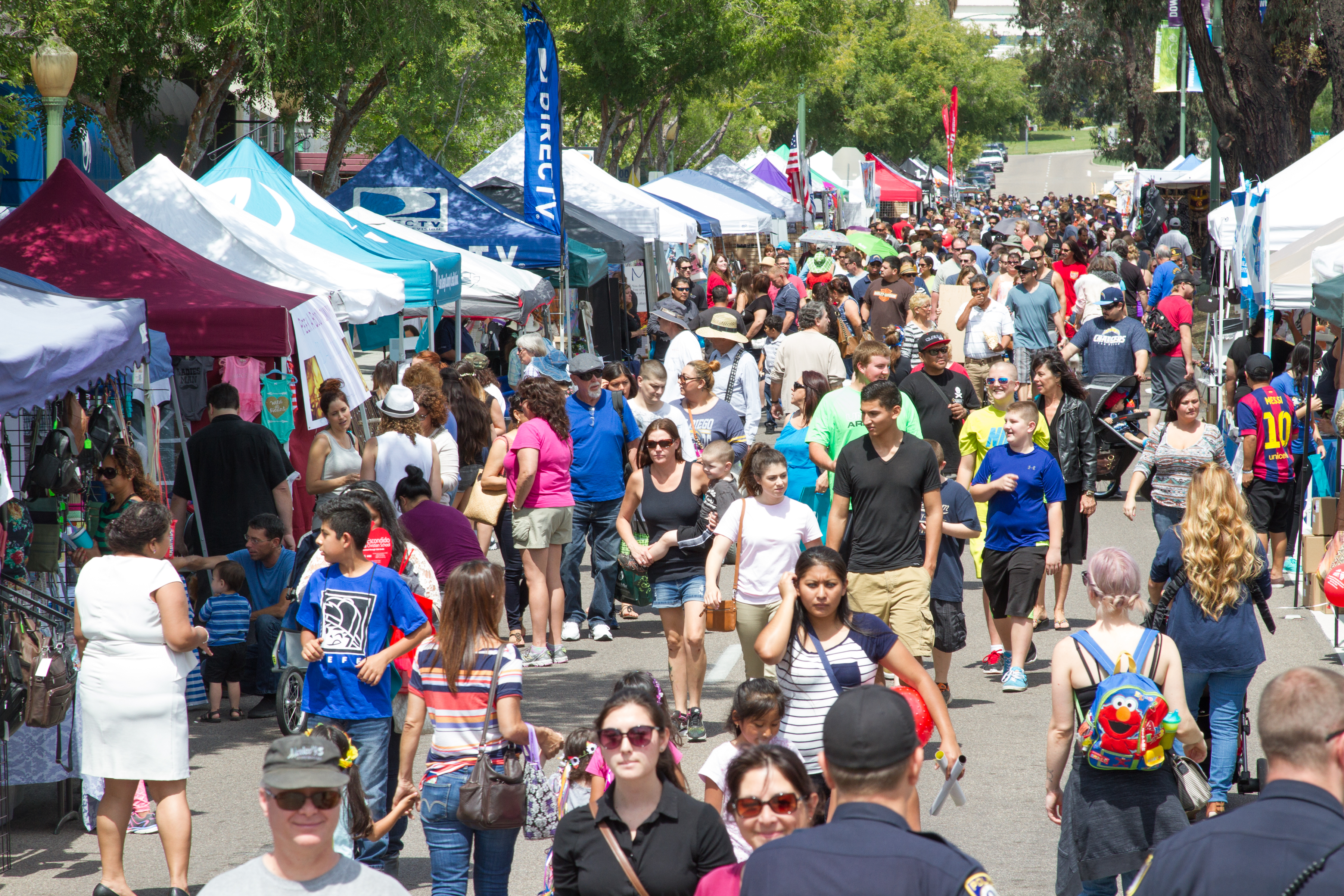The company that invites you to "discover your perfect wedding" has found its perfect home - in Downtown Escondido.
 Wedding planning in Escondido just became a whole lot easier
Wedding planning in Escondido just became a whole lot easier
Trademark Venues, an event planning company that owns and operates several of the region's most storied and exclusive wedding venues, has taken up shop in the former Draper's and Damon's building at the southeast corner of Grand Avenue and Broadway in the heart of downtown.
They are also opening a bridal boutique in the adjacent space this month.
The company is one of the hottest names in the wedding planning industry. Recently, "Bachelor in Paradise" alumni Chris Randone and Krystal Nielsen celebrated their engagement with a lavish party held at Ethereal Gardens, one of Trademark's signature venues.
The company's representatives said they are proud to call Escondido the home base of the operations, which includes wedding venues in Escondido, San Marcos and a future location in Bonsall.
"We saw the building and we absolutely fell in love with it," said Kevin MacGregor, Trademark Venue's marketing director. "We see the growth and potential and how downtown is changing so much and we wanted to add to that."
What they do
From outside the Grand Avenue storefront on a Wednesday morning, you can see the hustle and bustle inside of the newly refurbished building, as members of the coordination team get set to meet with clients to go over the details of their dream wedding.
Trademark specializes in what MacGregor called "handcrafted weddings" - a wedding planning experience that seeks to create a deeply personal wedding day, and a process that touches on everything from dance lessons to wine tastings and every step in between.
At the center of the process are the venues:
- Ethereal Gardens, located on a 40-acre organic farm on the upper reaches of Escondido which the website describes as "an 'out of the box' venue that is completely private and not just another golf course, winery, banquet hall or hotel. Here we are open to creative ideas and outside vendors such as florists, photographers, photo booths, food trucks and so much more."
- Green Gables, the iconic hilltop venue along near Woodland Parkway in San Marcos, described on the website as an "enchanting secluded wonderland. In the shade of a lush, landmark forest, this historic garden estate is surrounded by ivy-covered arbors, blooming rose gardens, trickling fountains, picturesque statuary, and thousands of bright twinkling lights."
- The Twin Oaks House and Gardens, which features a fully restored 1891 historic home along Deer Springs Road in San Marcos, described as a "secluded vintage venue that features artistic and poetic gardens inspired by love, imagination and tranquility."
Couples start their journey with Trademark by touring each of the three venues. Once they select a venue and reserve a date, the journey begins.
"We handcraft the wedding and tailor it to make your perfect day," MacGregor said. "We see the venues as the backdrop and help the couple decorate it as they've seen it in their dreams."
That includes the road to the wedding, where Trademark offers custom wedding packages tailored to each couple. This includes dinner-style options, the colors, the furniture, props, dance lessons, wine and food tastings, the decor and more.
"Whether you are accenting our orchard barn, brick and timber chapel, starry night meadow, nature pond, English garden, cut stone fireplace, passion vine greenhouse, garden pergola, tree house, turn post gazebo or historic forest. at Trademark we have your perfect backdrop," MacGregor said.
And Trademark offers total privacy and exclusivity with each wedding - they only book one event per day, and couples have the venue for nearly 12 hours.
"We don't want you rushing on your special day, it is 100 percent your venue for the day," MacGregor said.
A home in Escondido
For most of its existence, Trademark's wedding coordinators and client relations staff have operated on-site at the venues, but MacGregor said that company CEO Karen Sherman envisioned a hub that would serve as home base.
Enter downtown Escondido, where the location of the iconic Draper's and Damon's women's clothing store had been vacant since April 2017.
It was love at first sight, MacGregor said.
"We specialize in taking historic landmark properties, like Green Gables and Twin Oaks, and paying tribute to their history," MacGregor said. "We fully understand and appreciate that we are taking care of the building," MacGregor said. "Jay Leno once said about his collection of cars that he didn't own them, but was merely taking care of them for the next owner, and that's how we feel about the building."
Inside, the building bursts with new life, the showroom full of shimmering chandeliers, tables adorned with sleek champagne flutes and wedding decor and other props showcasing the company's wares.
MacGregor said that the business has been well received by neighbors, the Chamber of Commerce, the Downtown Escondido Business Association, and the City of Escondido.
"Everything is easy when it's meant to be," MacGregor said. "It's been all smiles and everyone has been very welcoming and helpful."
MacGregor said that from a personal perspective, the rebirth of Escondido's historic core is profound.
"I grew up in Carlsbad, and I couldn't believe how much Escondido has changed the past few years," MacGregor said.
And employees have been well-received downtown, as they frequent spots like the Burger Bench and Kettle Coffee & Tea in large groups, boosting the local economy.
"We can directly see our footprint in downtown and are excited to see where it leads," MacGregor said. "And I am a car guy, so Cruisin' Grand is a nice treat on Friday nights."
Additionally, MacGregor said, in each city where Trademark has a venue, it actively promotes local vendors to its clients.
Escondido's economic development manager Michelle Geller praised the addition of Trademark to downtown, which she said complements a number of existing businesses, potentially making Downtown Escondido a one-stop shop for the couples planning their big day.
"Trademark Venues' new location on a prominent corner at Broadway and Grand is a great addition to our downtown," Geller said. "There are many complementary businesses nearby like Something Old, Something New Bridal Boutique, The Grand Tea Room and SIP Wine & Beer. I can definitely see future brides, grooms and their friends making a day of it in Downtown Escondido while they plan their big day."
Escondido is proud to be the new home of Trademark Venues and looks forward to their continued growth and success.
Subscribe to "Escondido Business Insight" for more stories like this delivered monthly to your inbox.
Grand Avenue Festival
Street fairs can be a tricky proposition for the brick-and-mortar businesses along the streets where the fairs are held.
The outdoor flea-market style events drive thousands of people to local streets for the vendors, food, music acts, and activities, but street vendors - not the shops - historically benefit from the foot traffic.
In Downtown Escondido, a small, but significant change to its semi-annual Grand Avenue Festival has made the street fair a win-win for local businesses and outdoor vendors alike.
 An exciting change in layout is coming to this year's Grand Avenue Festival
An exciting change in layout is coming to this year's Grand Avenue Festival
Rather than lining the streets with vendors in front of the businesses, which is usually the case at street fairs, the fair's organizers moved the booths to both sides of the center median running down Grand Avenue between Centre City Parkway and Ivy Street, leaving the sidewalks and storefronts visible to visitors.
Grand Avenue Festival organizers piloted the change at the October 2018 installment to rave reviews and record sales days from shops and restaurants. They are ready for an even bigger reception at the spring installment on Sunday, May 19.
"We found it to be a huge success and a welcomed relief for a lot of businesses," said Chris Cochran, marketing and development director for the Escondido Chamber of Commerce. "Our goal now is to have that redesign in perpetuity. We're not going back to the old way."
How successful was the new setup? Just ask Ray Alto, owner of La Tapatia Mexican restaurant, which sits near the western edge of the festival between Orange Street and Escondido Boulevard.
Alto's restaurant got so busy during the October Grand Avenue Festival, that they ran out of many items on the menu.
"Carne asada burritos were really popular that day, and by the afternoon, we couldn't make anymore," Alto said. "When the booths were on the sidewalks, people couldn't walk through, so we were covered up. By putting them in the middle of the street, the sidewalk was open and a lot of business came our way. It was one of our best days ever."
Alto wasn't alone: Cochran said that Susy Q's Diner, Rosie's Cafe, Plan 9 Alehouse and several other businesses also posted record sales days.
"It was a huge success that was welcomed by the Downtown Business Association and its merchants," Cochran said.
Alex MacLachlan is the president of the Escondido Downtown Business Association, which represents the historic core's merchants.
MacLachlan said the association has spread the word to businesses about the new-found opportunity at their quarterly merchant meetings and through other communications.
Some businesses would shutter their doors during the festival, concerned they would lose money staying open, MacLachlan said. Now, however, businesses are seeing opportunities with the sidewalks open and their storefronts visible.
"We let them know that it's a good chance to reach out to new customers and to find ways to attract attention to their businesses," MacLachlan said. "We advocate for the merchants, and part of that is to let them know that this is going on, so we are still trying to get the world out that this is a big opportunity twice a year to get new customers and hopefully repeat business."
The revamped format has been in the works since 2017 when the business association and Chamber of Commerce approached the fair's contract operator, Kennedy and Associates, with the idea, which MacLachlan said drew out of inspiration from the Adams Avenue Street Fair in San Diego.
"We wanted to make it a positive for our merchants and we experienced that at the Adams festival, where we saw ice cream shops, restaurants, and other merchants participating, doing displays out on the sidewalk," MacLachlan said. "It was a good vibe and really easy for us to do that in Escondido, and we felt it would be super positive for the merchants when they got used to it and trusted that it would be a good opportunity for them."
To accomplish the logistical shift, the organizers got approval from the city to expand the street closure from Juniper to Ivy Street to the east and close a segment of Escondido Boulevard and Broadway.
The new format is also a hit with the vendors, Cochran said: the Chamber Commerce has received 50 more vendor requests than the previous installment in the fall.
"It's growing, and I think a lot of people are excited about the direction in which the fair is headed," he said.
The Grand Avenue Festival, previously known as the Grand Avenue Street Faire, is rooted in a pair of longtime festivals that occurred in the city's historic downtown - a fall arts fair run by the city and the Felicita Foundation and a spring festival put on by the business association.
When the city and foundation turned their attention towards completing the California Center for the Arts, they turned to the Chamber of Commerce to keep their fair going. And in the early 1990s, a city committee recommended the chamber and business association merge the two events into the semi-annual affair that continues to this day.
Today, visitors - organizers expect as many as 25,000 over the course of the day - can walk up and down six blocks of historic Escondido, perusing and shopping more than 400 vendors for unique hand-crafted gifts and imports, enjoying international cuisine and catching local entertainment on the Maple Street Plaza and Chase Bank lawn stages.
For the kids, there's the Creative Kids Corner at Juniper & Grand, and fine arts aficionados can enjoy the Art in the Garden at Heritage Garden. And for the furry, four-legged friend, there are the Dogs on the Lawn at the Chase lawn area on Grand & Orange, where dogs - and their two-legged companions - can compete in contests to win some fantastic prizes provided by PetSmart Escondido.
And of course, on either side of Grand and along the street fair route are the businesses - doors wide open, ready and inviting customers to enjoy downtown.
 A family brings its furry friends to the pet-friendly festival
A family brings its furry friends to the pet-friendly festival
If you go:
Sunday, May 19
9 a.m. to 5 p.m.
Details: The Grand Ave Festival, Escondido, takes place in our historic downtown on Grand Ave from Center City to Ivy. You'll be able to shop from hundreds of vendors for unique hand-crafted gifts and imports, and enjoy international cuisine, local entertainment, and much more! Such as the Creative Kids Corner at Juniper & Grand, and Art in the Garden at Heritage Garden! And be sure to bring your furry, four-legged friend to the Chase lawn area (Grand & Orange) for the Dogs On The Lawn contests to win some fantastic prizes provided by PetSmart Escondido!
Events all summer
Please make sure to visit the Visit Escondido special events calendars for the latest happenings in Escondido, including these upcoming events:
San Dieguito River Park 30th Anniversary Run, Tot Trot, and Fair
Sunday, June 9, 7:30 a.m. to 3:30 p.m.
Sikes Historical Adobe Farmstead
The San Dieguito River Park JPA is celebrating 30 years of environmental preservation, recreation, and education. Join us for the San Dieguito River Park 15k / 5k / 1k / Tot Trot trail runs! Race will be held on trails that are mostly flat with some rolling hills. Courses are a mixture of trails, sidewalk, and hard pack dirt trails. Both events in partial view of Lake Hodges and the beautiful San Dieguito River Park area. 5 Years and under FREE with parent entered.
56th Annual Independence Day Festival & Fireworks
Thursday, July 4, 2019 at 4 p.m.
Grape Day Park & The Center's Great Green
This free community event features rockin' live music, fabulous food vendors, and a wealth of children's activities and games for everyone to enjoy. The day's festivities will conclude with a special performance by the 3rd Marine Aircraft Wing Band and, of course, dazzling fireworks display starting at 9:00 p.m. You won't want to miss this annual North County tradition!
Subscribe to "Escondido Business Insight" for more stories like this delivered monthly to your inbox.